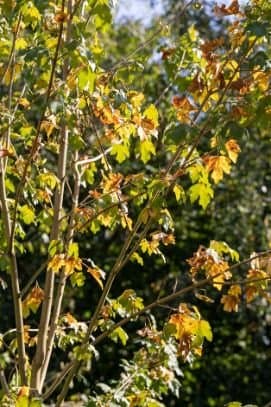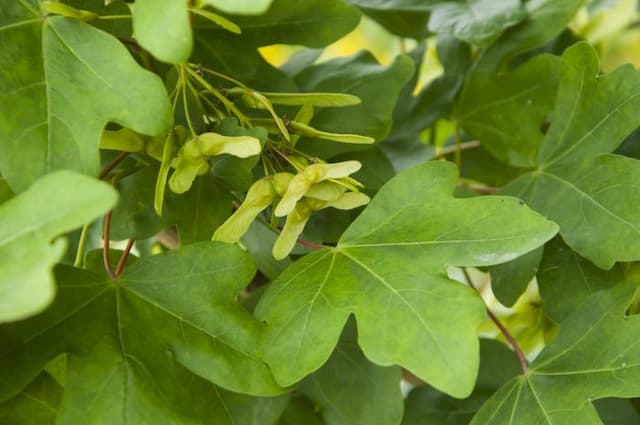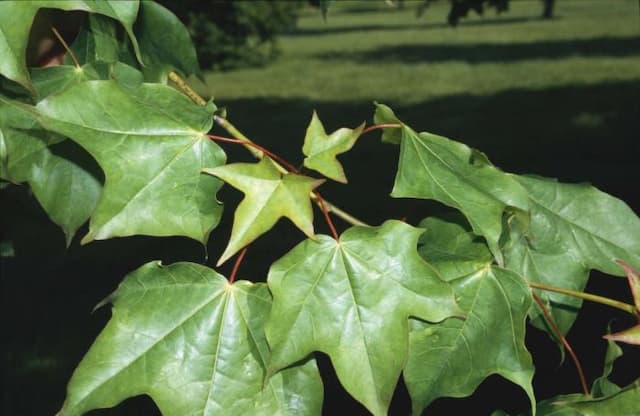Kawakami maple Acer caudatifolium

ABOUT
Acer caudatifolium, commonly known as Kawakami maple, is a plant characterized by its ornamental foliage and attractive structural form. The leaves of this plant are one of its most distinctive features; they are typically lobed with elongated tips, giving a somewhat 'feathery' appearance. During the growing seasons, the color of the leaves can change, starting off with hues of green and transitioning to vibrant shades of yellow, orange, or red as the cooler months draw in, providing a striking visual display. The bark of the Kawakami maple is smooth, with a grayish-brown color that provides a subtle backdrop to its colorful leaves. Flowers on this plant are small and may not be immediately noticeable. They usually bloom in subtle tones that blend in with the foliage. Following the flowering season, the plant produces winged seeds that are a distinguishing feature of maples, spinning like helicopters as they fall to the ground, aiding in their dispersal. Overall, the Kawakami maple has a pleasing rounded to oval canopy which creates an elegant silhouette against the sky. Its branch structure is delicate and intricate, making it a favorite in gardens for both its shape and seasonal color changes.
About this plant
 Names
NamesFamily
Sapindaceae.
Synonyms
Kao-mei Maple, Taiwan Maple, Kawakamii Maple.
Common names
Acer caudatifolium, Acer caudatifolium var. ukurunduense, Acer ukurunduense.
 Toxicity
ToxicityTo humans
Acer caudatifolium, commonly known as the Kawakami maple, is not widely recognized for having toxic properties to humans. There is limited information on the toxicity of this specific maple species. The toxicity of maple trees in general to humans is considered low, and ingestion of parts of Acer caudatifolium isn't commonly associated with severe poisoning or health hazards. However, as with many plants, it is still advisable to avoid consuming parts of plants that are not known to be edible, as individual allergic reactions or sensitivities can occur.
To pets
Acer caudatifolium, also known as Kawakami maple, does not have a well-documented history of being toxic to pets. Most maples are not considered highly toxic to pets, although some species can pose risks under certain circumstances. One exception is the red maple (Acer rubrum), which can be toxic to horses if large quantities of wilted leaves are ingested, leading to hemolytic anemia. For the Kawakami maple, there is no specific information indicating significant toxicity to pets such as dogs and cats. Nevertheless, it's always prudent to prevent pets from ingesting plants that are not part of their native diet to avoid the possibility of unforeseen allergic reactions or gastrointestinal upset.
 Characteristics
CharacteristicsLife cycle
Perennials
Foliage type
Deciduous
Color of leaves
Green
Flower color
Yellow
Height
20-30 feet (6-9 meters)
Spread
20-30 feet (6-9 meters)
Plant type
Tree
Hardiness zones
7
Native area
Taiwan
Benefits
 General Benefits
General Benefits- Ornamental Value: Acer caudatifolium, commonly known as Kawakami maple, is highly valued for its aesthetic appeal and is often used in landscaping and garden design for its attractive foliage.
- Shade Provision: The broadleaf canopy of the Kawakami maple provides ample shade in gardens and parks, creating comfortable outdoor spaces.
- Seasonal Interest: This maple species offers year-round visual interest with its changing leaf colors through the seasons, from fresh green in spring to vibrant reds and oranges in autumn.
- Habitat for Wildlife: Kawakami maple trees can serve as habitats and food sources for various bird species, insects, and other wildlife, thus contributing to biodiversity.
- Erosion Control: The root system of Acer caudatifolium helps stabilize soil, preventing erosion on slopes and in areas with loose soils.
 Medical Properties
Medical PropertiesThis plant is not used for medical purposes.
 Air-purifying Qualities
Air-purifying QualitiesThis plant is not specifically known for air purifying qualities.
 Other Uses
Other Uses- Huangshan maple (Acer caudatifolium) wood can be used for fine woodworking or cabinet making due to its grain and texture.
- The leaves of the Huangshan maple can serve as a food source for livestock when other forage is not available.
- In landscaping, the Huangshan maple can be used as a natural shade provider in gardens and parks, thanks to its broad canopy.
- The tree's ornamental features, especially the vibrant fall color of its leaves, make it a popular choice for ornamental planting and seasonal displays.
- Maple syrup production is a potential use for the sap of the Huangshan maple, similar to that of other maple species.
- The Huangshan maple can be used in bonsai culture, where its foliage and growth pattern can be artistically shaped over time.
- Wood from the Huangshan maple may be used in the crafting of musical instruments, such as guitars or violins, for its acoustic properties.
- The bark of the Huangshan maple might be used in landscaping as mulch, providing nutrients to the soil as it decomposes.
- Dried leaves of the Huangshan maple can be included in potpourri mixes for their aesthetic appeal and potential subtle fragrance.
- Leaf imprints from the Huangshan maple can be used in artwork or as a tool for teaching about plant morphology in educational settings.
Interesting Facts
 Feng Shui
Feng ShuiThe plant Acer caudatifolium, commonly known as the Kawakami maple, is not used in Feng Shui practice.
 Zodiac Sign Compitability
Zodiac Sign CompitabilityThe plant Acer caudatifolium, commonly known as the Kawakami maple, is not used in astrology practice.
 Plant Symbolism
Plant Symbolism- Endurance – Acer caudatifolium, commonly known as the Kawakami Maple, is a species that has adapted to grow in various conditions, representing the ability to withstand diverse environments and symbolizing endurance.
- Strength – Maples are typically associated with strength due to their hard, durable wood, which can be a metaphor for inner strength in adversity.
- Beauty – With its attractive foliage that changes color across seasons, the Kawakami Maple symbolizes natural beauty and the appreciation of aesthetic changes over time.
- Grace – The delicate leaves and elegant branching pattern can represent gracefulness, symbolizing harmony and a balanced approach to life.
- Transformation – The seasonal changes experienced by the Kawakami Maple, from vibrant green leaves in spring to fiery hues in autumn, symbolize transformation and the cyclical nature of life.
 Water
WaterThe Taiwan maple, commonly known as Acer caudatifolium, prefers consistent moisture and should be watered deeply once a week, allowing the soil to slightly dry between waterings. In the absence of rain, provide it with about 1 to 1.5 gallons of water, ensuring that you're reaching the root zone without oversaturating the soil. It's important to reduce the frequency during fall and winter to prevent root rot, adjusting for rainfall and temperature changes.
 Light
LightThe Taiwan maple thrives best in partial shade to full sun. An ideal spot for this plant is where it can enjoy bright morning sun and is protected from the harsh afternoon sun. Placing it in an area with filtered light throughout the day would also suit its lighting needs, avoiding prolonged direct sun exposure which can scorch the leaves.
 Temperature
TemperatureThe Taiwan maple can tolerate a range of temperatures but performs best when the climate is between 60°F and 75°F. It can survive minimum temperatures down to around -10°F and maximum temperatures up to 80°F. However, to ensure optimal growth and health, it should be protected from extreme temperature fluctuations and harsh winter conditions.
 Pruning
PruningPruning the Taiwan maple is essential for maintaining its shape and promoting healthy growth. Pruning should be done in late winter or early spring before new growth begins. Remove any dead or damaged branches, thin out overcrowded areas to increase air circulation, and shape as desired. It's generally necessary to prune this maple annually or every other year.
 Cleaning
CleaningAs needed
 Soil
SoilTaiwanese maple prefers a soil mix consisting of equal parts peat, perlite, and pine bark with a slightly acidic to neutral pH of 5.5 to 7.5 for optimal growth and health.
 Repotting
RepottingTaiwanese maples should be repotted every 2 to 3 years, or when the root system outgrows the container, to ensure continued healthy growth.
 Humidity & Misting
Humidity & MistingTaiwanese maple thrives in moderate to high humidity levels, ideally between 50% to 70%, which mimics its natural forest habitat conditions.
 Suitable locations
Suitable locationsIndoor
Place Taiwanese maple in bright, indirect light and ensure high humidity.
Outdoor
Ensure partial shade, protect from strong winds, and maintain moisture.
Hardiness zone
7-9 USDA
 Life cycle
Life cycleThe Taiwanese Sweet Gum (Acer caudatifolium) starts its life as a seed, which germinates in spring when soil moisture and temperature conditions are adequate. Upon germination, the seedling emerges and begins to grow a root system and a shoot which will develop into the trunk and branches. Over the next several years, the sapling continues to grow, developing a canopy of leaves which undergo photosynthesis to fuel further growth. As the tree matures, it will start to flower and once pollinated—often by wind—these flowers will develop into samaras, the characteristic winged fruit of maples. These samaras will eventually disperse from the parent tree, often by wind, to propagate the species and start the next generation. The Taiwanese Sweet Gum can live for many decades and will go through multiple reproductive cycles, flowering annually, while continuing to grow until reaching its mature size.
 Propogation
PropogationPropogation time
Spring-early summer
The most popular method of propagation for the Acer caudatifolium, commonly known as the Kawakami maple, is by seed. The best time to collect seeds is when they mature in the fall. After collection, the seeds require a period of cold stratification to break dormancy; this involves mixing the seeds with moist sand and storing them in a refrigerator at about 34-40°F (1-4°C) for 60-90 days. Once the stratification period is complete, the seeds can be sown in well-draining seed starting mix, lightly covered, and kept at a temperature of 70-85°F (21-29°C). It's crucial to keep the soil consistently moist but not waterlogged. Seedlings will emerge in the spring, and once they have grown sturdy enough, they can be potted into individual containers or planted in their desired location outdoors.









